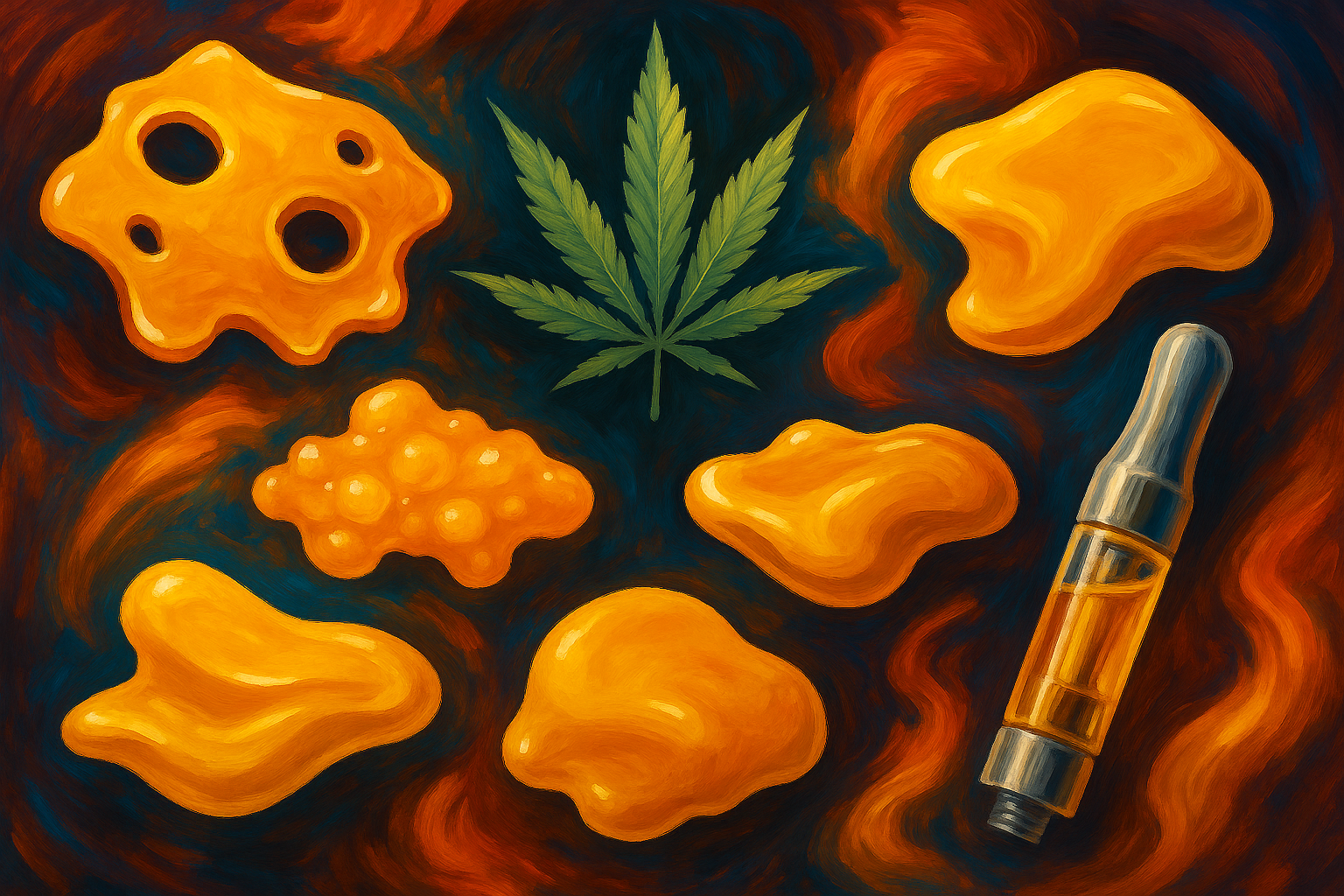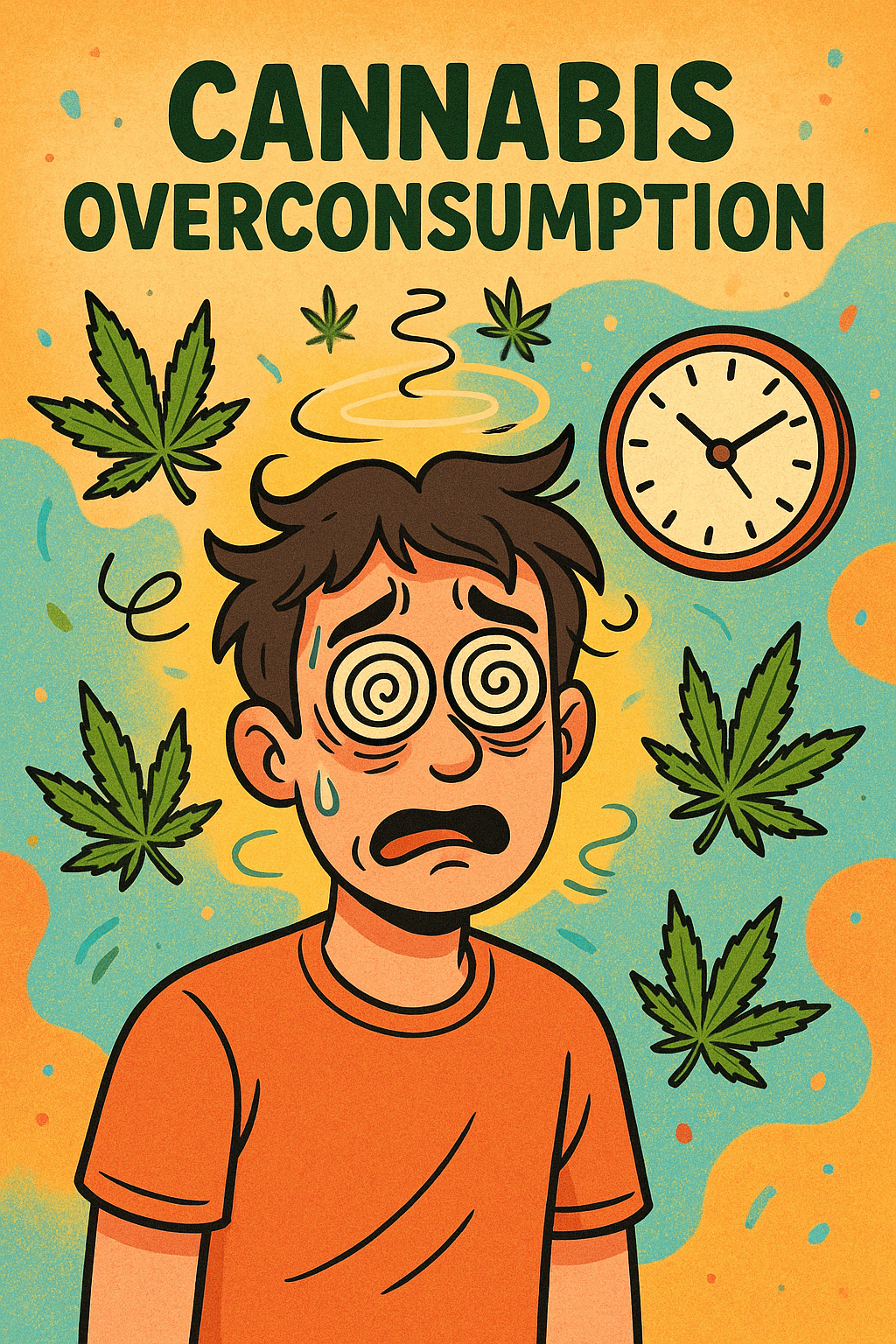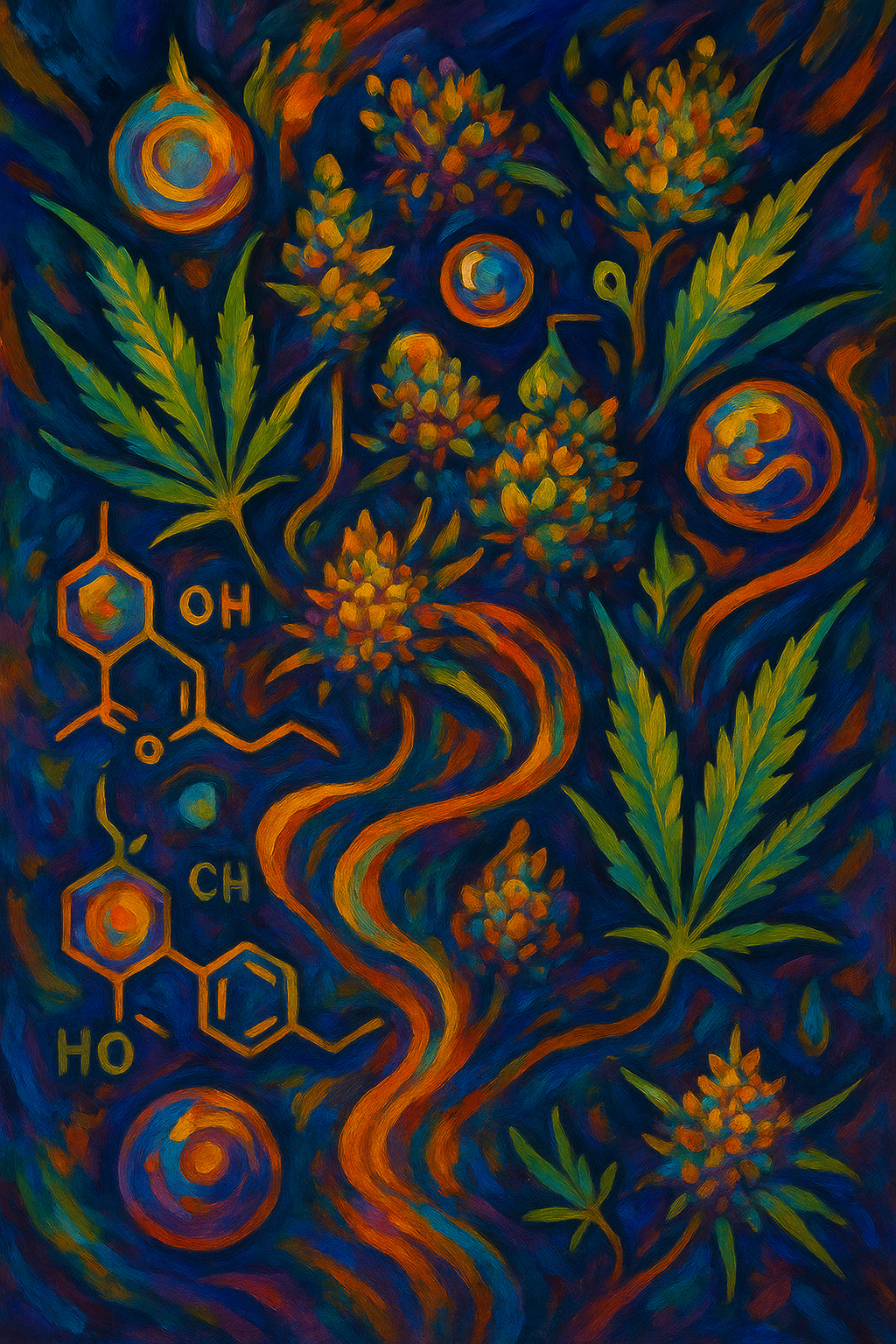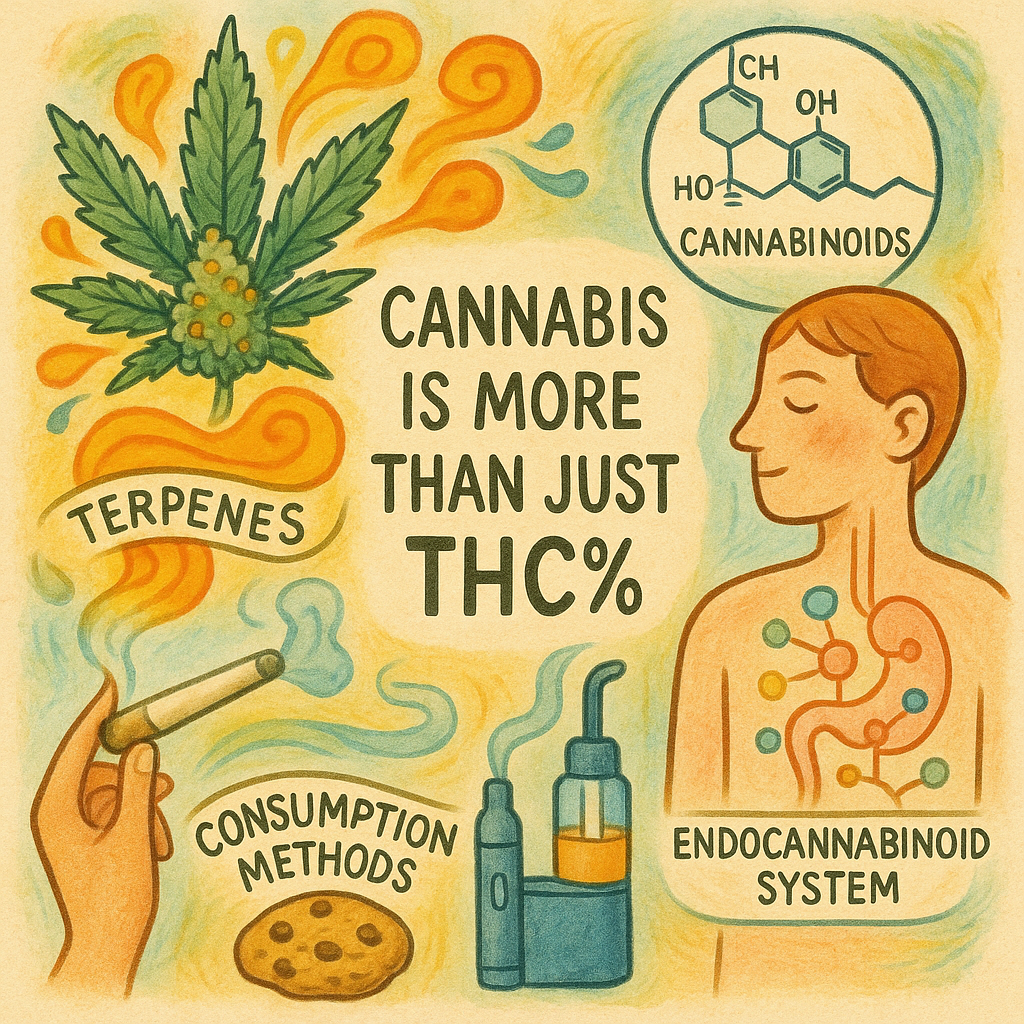The Roach
5-Minute Read: Cannabis Concentrates Made Easy
Introduction
Cannabis concentrates are powerful extracts made from the cannabis plant, offering higher potency and unique flavors compared to traditional flower. This summary will help you understand the main types, how they’re made, and tips for choosing the right concentrate for you.
1. What Are Cannabis Concentrates?
-
Concentrates are products where the most desirable parts of the cannabis plant (cannabinoids and terpenes) are extracted, leaving out most of the plant material.
-
They come in many forms, each with different textures, potencies, and flavors.
2. Two Main Types: Solvent-Based vs. Solventless
Solvent-Based Concentrates
-
Made using chemicals like butane, propane, CO₂, or ethanol to extract cannabinoids and terpenes.
-
Common types:
-
Shatter: Glass-like and brittle.
-
Wax/Budder: Soft and creamy.
-
Sugar/Crumble: Grainy or crumbly texture.
-
Live Resin: Made from fresh, frozen plants for more flavor.
-
Distillate: Highly purified, nearly flavorless, very potent.
-
Sauce/HTE: Rich in terpenes, with crystals in a liquid.
Solventless Concentrates
-
Made without chemicals, using heat, pressure, or ice water.
-
Common types:
-
Rosin: Squeezed from flower or hash using heat and pressure.
-
Hash/Bubble Hash: Made by separating trichomes with ice water.
-
Dry Sift: Made by sifting dried cannabis through screens.
3. Live Resin vs. Cured Resin
-
Live Resin: Uses fresh, frozen cannabis. Preserves more terpenes for stronger aroma and flavor.
-
Cured Resin: Uses dried and cured cannabis. Usually less flavorful but more stable and affordable.
4. Vape Cartridges: What’s Inside?
-
Distillate Carts: High THC, mild flavor, often with added terpenes.
-
Live Resin Carts: Full of natural flavor and aroma, thanks to preserved terpenes.
-
Sauce/HTE Carts: Maximum flavor, but can be more expensive and sometimes clog easily.
5. How to Choose the Right Concentrate
-
Beginners: Start with lower-potency products like hash or rosin.
-
Flavor Seekers: Try live resin, sauce, or HTE for rich, natural flavors.
-
Medical Users: Look for full-spectrum or broad-spectrum products for more balanced effects.
-
Budget: Distillate and cured resin are usually more affordable.
Quick Tips
-
Always buy from licensed dispensaries for safety and quality.
-
Check lab test results (COAs) for potency and purity.
-
Start with a small amount—concentrates are much stronger than flower.
-
Store concentrates in a cool, dark place.
Key Takeaway
Cannabis concentrates offer a wide range of experiences, from potent highs to rich flavors. Understanding the differences between types and how they’re made helps you choose the best product for your needs—safely and confidently.
The Weekly Dab
(Deep Dive)
Cannabis concentrates represent one of the fastest-growing segments in the legal cannabis industry, offering consumers potent alternatives to traditional flower with significantly higher cannabinoid content and diverse consumption methods[1][2]. This comprehensive guide explores the fundamental differences between concentrate types, breaking down complex extraction processes into easy-to-understand concepts while examining specialized products like sauce cartridges, live resin carts, and high terpene extracts[3][4]. Understanding these distinctions empowers consumers to make informed decisions about products that can contain anywhere from 40% to 95% THC, compared to flower's typical 15-25% range[1][2][3].
Understanding Cannabis Concentrates: The Two Main Categories
Cannabis concentrates are highly potent extractions that capture the plant's essential compounds - primarily cannabinoids like THC and CBD, along with aromatic terpenes[1][2]. All concentrates fall into two fundamental categories based on their production methods: solvent-based and solventless extractions[2][5][6].
Cannabis concentrates educational infographic showing main categories
The key distinction lies in how manufacturers separate the valuable trichomes (resin glands) from the plant material[2][5]. Solvent-based methods use chemical substances like butane, propane, CO2, or ethanol to dissolve and extract cannabinoids and terpenes[2][5][7]. Solventless methods rely purely on physical processes such as heat, pressure, ice water agitation, or mechanical separation to collect trichomes without any chemical solvents[5][6][8].
This fundamental difference affects everything from safety protocols and equipment costs to the final product's purity, flavor profile, and market price[5][7]. Solvent-based extractions typically achieve higher yields and faster production times, making them ideal for commercial-scale operations[5][7]. Solventless methods produce cleaner products with no risk of residual solvents, appealing to health-conscious consumers who prefer natural extraction processes[5][6][9].
Solvent-Based Concentrates
Butane Hash Oil (BHO) and Propane Hash Oil (PHO) Products
Butane and propane extractions dominate the solvent-based concentrate market, producing the widest variety of textures and consistencies[2][3][4]. The solvent choice and post-processing techniques determine whether the final product becomes shatter, wax, budder, or other formats[2][3].
Shatter represents the most stable BHO product, characterized by its glass-like appearance and brittle texture[3][4]. The transparent, amber-colored concentrate contains 70-90% THC and breaks cleanly when handled, making it easy to portion for dabbing or vaping[3][4]. Shatter's stability comes from minimal agitation during purging, allowing molecules to align in a uniform structure[3].
Wax and Budder result from whipping the extract during purging, introducing air that creates their distinctive opaque, soft textures[1][2][3]. Wax appears more granular while budder achieves a creamy, frosting-like consistency[1][2]. Both typically contain 60-80% THC with moderate terpene retention, offering good flavor profiles for dabbing or incorporating into edibles[1][2][3].
Sugar and Crumble concentrates develop naturally during certain extraction conditions, creating granular, crystalline textures[2][3]. These products maintain 70-85% THC content with medium terpene levels, providing flavorful dabbing experiences[2][3].
Live Resin vs Cured Resin
The starting material fundamentally differentiates live resin from cured resin products[10][11][8]. Live resin uses fresh cannabis that's immediately frozen after harvest, preserving volatile terpenes that would otherwise degrade during traditional drying and curing[10][11][8]. This process captures the plant's peak terpene profile, resulting in exceptionally flavorful concentrates with 15-25% terpene content[10][11].
Live Resin vs Cured Resin: Key Differences Comparison
Cured resin utilizes dried and cured cannabis flower, following traditional preparation methods[10][11]. While this reduces terpene content to 10-18%, cured resin offers greater stability, longer shelf life, and more economical production costs[10][11]. The drying and curing process also develops different flavor compounds, appealing to consumers who prefer traditional cannabis taste profiles over the fresh, grassy notes of live resin[10][11].
Sauce and High Terpene Extract (HTE)
Sauce concentrates prioritize terpene preservation above all else, achieving 20-30% terpene content through specialized extraction and separation techniques[12][13][14]. The production process encourages cannabinoid crystallization, creating THCA "diamonds" suspended in terpene-rich liquid sauce[12][13][15]. This separation allows for varying ratios of crystals to sauce, producing different consistency and potency levels within the same product[12][13].
High Terpene Extract (HTE) represents the ultimate expression of terpene preservation, containing 25-35% terpenes while maintaining 55-70% total cannabinoids[16][17]. HTE production requires precise temperature control and specialized equipment to prevent terpene degradation during extraction[16][17]. The resulting concentrate delivers exceptional flavor intensity and pronounced entourage effects from the full spectrum of preserved aromatic compounds[16][17].
Distillate
Distillate stands apart from other concentrates through its purification process, achieving 90-95% cannabinoid content through fractional distillation[3][18]. This refinement removes virtually all terpenes, plant matter, and other compounds, creating a clear, odorless, and flavorless product[18][19]. While distillate lacks the flavor complexity of other concentrates, its neutral taste and extreme potency make it ideal for edibles, precise dosing, and cartridges where added terpenes can create custom flavor profiles[18][19].
Solventless Concentrates
Rosin Production
Rosin extraction uses only heat and pressure to squeeze resinous oils from cannabis material, requiring no chemical solvents[8][20][21]. A rosin press applies controlled temperature (typically 180-220°F) and pressure (1000+ PSI) to flower, hash, or kief, causing trichome heads to burst and release their contents onto collection parchment[20][21][9].
The simplicity of rosin production appeals to home extractors and commercial producers alike[20][21]. Basic rosin can be made with a hair straightener and parchment paper, while commercial operations use pneumatic or hydraulic presses for consistent results[20][21]. The immediate nature of rosin extraction allows producers to go from starting material to finished concentrate in minutes[20][21].
Live Rosin represents the premium tier of solventless concentrates, combining rosin's clean extraction method with live resin's terpene preservation[8][21]. Fresh frozen cannabis first undergoes ice water extraction to create bubble hash, which then gets pressed into live rosin[21][22]. This two-step process preserves maximum terpene content while maintaining the solventless purity that many consumers prefer[8][21].
Hash Varieties
Traditional hash production involves collecting and pressing cannabis trichomes through various mechanical methods[4][23][24]. Modern ice water extraction (bubble hash) uses agitation in freezing water to separate trichomes, which are then filtered through increasingly fine mesh bags[22][23][24]. The resulting product ranges from lower-grade cooking hash to pristine "6-star" bubble hash suitable for dabbing or pressing into rosin[22][23][24].
Dry Sift hash uses graduated screens to separate trichomes from dried cannabis through gentle agitation[23][24]. High-quality dry sift appears as a blonde, powder-like concentrate that can be pressed into traditional hash or used as starting material for rosin production[23][24]. Static tech refinement further purifies dry sift by removing plant contaminants using electrostatic separation[24].
Cannabis Cartridge Types and Subcategories
Understanding Cartridge Categories
Cannabis vape cartridges contain concentrated oils designed for use with battery-powered vaporizers, offering discrete and convenient consumption methods[25][19]. The type of extract used in cartridge production significantly affects flavor, potency, and effects[25][19][18].
| Cartridge Type | Extract Used | THC Content (%) | Terpene Content (%) | Starting Material | Flavor Profile | Effects | Price Range | Best For |
| Distillate Carts | Cannabis Distillate | 85-95 | 2-8 | Any cannabis | Mild/Added terps | Strong, clean high | Budget-Friendly | New users, potency seekers |
| Live Resin Carts | Live Resin Extract | 70-85 | 15-25 | Fresh frozen flower | Rich strain flavor | Full entourage effect | Premium | Connoisseurs, flavor lovers |
| Cured Resin Carts | Cured Resin Extract | 65-80 | 10-18 | Dried & cured flower | Good strain flavor | Balanced high | Mid-Range | Regular users |
| Sauce Carts | Terp Sauce | 60-75 | 20-30 | Fresh frozen (specialty) | Intense flavor | Flavorful, potent | Ultra-Premium | Terpene enthusiasts |
| Full Spectrum Carts | Full Spectrum Extract | 70-85 | 12-20 | Whole plant | Balanced natural | Complete plant benefits | Premium | Medical patients |
| HTE Carts | High Terpene Extract | 55-70 | 25-35 | Terpene-rich strains | Exceptional flavor | Flavor-focused high | Ultra-Premium | Flavor connoisseurs |
| Broad Spectrum Carts | Broad Spectrum Extract | 70-85 | 15-22 | Whole plant (THC removed) | Natural without THC | Entourage minus THC | Premium | THC-sensitive users |
Cannabis Vape Cartridge Types Comparison
Distillate Cartridges dominate the market due to their affordability and high THC content[19][18]. These cartridges contain 85-95% THC with minimal terpenes (2-8%), often enhanced with added botanical or cannabis-derived terpenes for flavor[19][18]. Their neutral base makes distillate cartridges versatile for creating consistent flavor profiles across different batches[19][18].
Live Resin Cartridges preserve the full terpene spectrum from fresh frozen cannabis, delivering 70-85% THC with 15-25% terpenes[10][11][19]. These premium cartridges provide rich strain-specific flavors and full entourage effects from the preserved plant compounds[10][11][19]. The high terpene content can cause hardware compatibility issues and shorter shelf life compared to distillate products[10][11].
Specialty Cartridge Types
Sauce Cartridges contain liquefied terp sauce, offering intense flavor profiles with 20-30% terpene content[12][26][14]. These ultra-premium products appeal to terpene enthusiasts seeking maximum flavor intensity, though their high terpene content can cause extraction separation and hardware clogging[12][26][14].
HTE (High Terpene Extract) Cartridges represent the pinnacle of flavor-focused vaping, containing 25-35% terpenes with 55-70% cannabinoids[16][17]. These cartridges deliver exceptional aromatic experiences but require specialized hardware and careful storage to maintain quality[16][17].
Full Spectrum Cartridges aim to preserve the complete cannabinoid and terpene profile of the original plant[27][28][29]. With 70-85% THC and 12-20% terpenes, these cartridges provide balanced effects from the full range of plant compounds[27][28][29]. Medical patients often prefer full spectrum products for their comprehensive therapeutic potential[27][28][29].
Broad Spectrum Cartridges offer full plant benefits without THC, containing 70-85% CBD with 15-22% terpenes[27][28]. These products serve consumers who want entourage effects without psychoactive THC, making them suitable for workplace drug testing concerns[27][28].
Live Resin vs Cured Resin: A Detailed Comparison
Production Differences
The fundamental distinction between live and cured resin begins at harvest[10][11][8]. Live resin production requires immediate freezing of freshly cut cannabis to subzero temperatures, preventing terpene degradation that occurs at room temperature[11][8][21]. This preservation method maintains the plant's living chemistry, capturing volatile compounds that would otherwise evaporate during traditional drying[11][8].
Cured resin follows conventional cannabis preparation, with plants hung to dry for 1-2 weeks followed by weeks of controlled curing in sealed containers[10][11]. This process removes moisture, breaks down chlorophyll, and develops different flavor compounds, but results in significant terpene loss compared to fresh frozen material[10][11].
Quality and Market Positioning
Live resin commands premium pricing due to its superior terpene preservation and more complex production requirements[10][11][18]. The fresh frozen starting material costs more to produce and store, while extraction requires specialized low-temperature equipment[11][8]. However, the resulting concentrate delivers unmatched flavor intensity and strain-specific effects that justify the higher cost for many consumers[10][11].
Cured resin offers excellent value for regular cannabis users seeking quality concentrates without premium pricing[10][11]. The established production methods and stable characteristics make cured resin ideal for consistent product lines and volume production[10][11]. Many consumers prefer cured resin's developed flavor profile over live resin's fresh, sometimes grassy taste[10][11].
Extraction Processes Explained
Solvent-Based Extraction Methods
Solvent-Based vs Solventless Cannabis Extraction Methods
BHO/PHO Extraction uses liquid butane or propane passed through cannabis material in closed-loop systems[2][7][30]. The solvent dissolves cannabinoids and terpenes while leaving plant matter behind[2][7]. The resulting crude oil undergoes purging in vacuum ovens to remove residual solvents, with different purging techniques creating various textures[2][7]. Safety requires explosion-proof facilities due to the flammable nature of hydrocarbon solvents[7][30].
CO2 Extraction employs supercritical carbon dioxide to selectively extract compounds at specific temperatures and pressures[7][30]. This method offers precise control over extraction parameters, allowing targeted compound isolation[7][30]. CO2 extraction produces cleaner products with no residual solvents, but equipment costs significantly exceed hydrocarbon systems[7][30]. The process typically yields lower terpene content due to CO2's effects on volatile compounds[7][30].
Solventless Extraction Techniques
Ice Water Extraction combines cannabis material with ice water and agitation to break trichome heads from plant material[21][22][24]. The mixture passes through bubble bags with progressively smaller micron screens, separating trichomes by size[22][24]. Different micron grades produce varying quality levels, with 70-120 micron typically yielding the highest grade "full melt" hash[22][24].
Rosin Pressing applies controlled heat and pressure to squeeze oils from cannabis flower, hash, or kief[20][21][9]. Temperature control prevents terpene loss while pressure breaks trichome membranes[20][21]. The immediate extraction allows real-time quality assessment and eliminates post-processing purging required for solvent-based methods[20][21].
Choosing the Right Concentrate for Your Needs
Beginner Considerations
New concentrate users should start with lower-potency options to gauge tolerance and preferred consumption methods[1][3]. Hash or lower-THC rosin products (40-60% THC) provide gentler introduction to concentrates compared to high-potency distillates or live resin[1][3]. Distillate cartridges offer consistent, predictable effects with minimal flavor complexity, making them ideal for beginners seeking straightforward experiences[19][18].
Advanced Consumer Preferences
Experienced users often gravitate toward terpene-rich products like live resin, sauce, or HTE for complex flavor profiles and enhanced entourage effects[10][12][16]. Solventless concentrates appeal to consumers prioritizing purity and natural extraction methods, despite higher costs and lower yields[5][6][8]. Dabbing enthusiasts typically prefer stable concentrates like shatter or rosin for easy handling and precise dosing[3][20].
Medical Applications
Medical cannabis patients benefit from full spectrum products that preserve the complete range of therapeutic compounds[27][29]. Consistent dosing becomes crucial for medical use, making standardized products like distillate advantageous for precise cannabinoid delivery[18][29]. Broad spectrum options serve patients requiring cannabinoid therapy without THC psychoactivity[27][28].
Conclusion
Cannabis concentrates offer diverse options for every consumer preference, from budget-friendly distillate cartridges to ultra-premium live rosin and sauce products[1][2][3]. Understanding the fundamental differences between solvent-based and solventless extraction methods empowers informed decision-making about purity, potency, and flavor priorities[2][5][6]. The choice between live and cured resin products depends on individual preferences for terpene intensity, price sensitivity, and desired effects[10][11].
As the concentrate market continues evolving, new extraction techniques and product formats emerge regularly, but the basic principles of solvent versus solventless production remain consistent[2][5]. Whether seeking maximum potency, exceptional flavor, or clean solventless purity, today's concentrate market provides options to satisfy every cannabis consumer's specific needs and preferences[1][2][3]. The key lies in understanding these fundamental differences to make educated choices that align with personal consumption goals and budget considerations[1][2][3].






Leave a comment (all fields required)